

Booroola Merino. The Booroola is a Merino strain that has a high rate of multiple births.
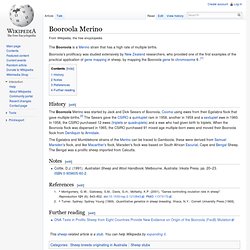
Booroola's prolificacy was studied extensively by New Zealand researchers, who provided one of the first examples of the practical application of gene mapping in sheep, by mapping the Booroola gene to chromosome 6 .[1] History[edit] The Booroola Merino was started by Jack and Dick Seears of Booroola, Cooma using ewes from their Egelabra flock that gave multiple-births.[2] The Seears gave the CSIRO a quintuplet ram in 1958, another in 1959 and a sextuplet ewe in 1960. In 1958, the CSIRO purchased 12 ewes (triplets or quadruplets) and a ewe who had given birth to triplets. When the Booroola flock was dispersed in 1965, the CSIRO purchased 91 mixed-age multiple-born ewes and moved their Booroola flock from Deniliquin to Armidale. Notes[edit] Cottle, D.J. (1991). References[edit] Jump up ^ Montgomery, G.W.; Galloway, S.M.; Davis, G.H.; McNatty, K.P. (2001). Further reading[edit] Awassi (sheep) Awassi ram in Kuwait The Awassi (Arabic: عواسي) is a local sheep breed in South-West Asia originated in the Syro-Arabian desert.

Other local names can also be Ivesi, Baladi, Deiri, Syrian, Ausi, Nuami or Gezirieh.[1] It is a fat-tailed type and is multi coloured: white with brown head and legs (sometimes also black or brown). The ears are long and drooping.[2] The Awassi is the most prevalent sheep breed in the Arab Countries. The Awassi sheep breed is common in most of the Middle East Countries including Saudi Arabia, Jordan, Iraq, Syria, Lebanon, and Palestine. An Awassi lamb in Israel It is used for a range of products; meat, milk and wool. Awassi sheep can be kept under a wide range of production systems, from nomadic flocks relying on natural pasture in semi-arid areas where lamb production is the primary products, to intensive dairy flocks where milk and lambs contribute almost equally to the flock gross income, and it is known for its hardiness and adaptability.[4]
Hebridean (sheep) Karayaka. Mouflon. The mouflon (Ovis orientalis orientalis[1] group) is a subspecies group of the wild sheep Ovis orientalis.

Populations of O. orientalis can be partitioned into the mouflons (orientalis group) and the urials (vignei group).[1] The mouflon is thought to be one of the two ancestors for all modern domestic sheep breeds.[2][3] Description[edit] Gute (sheep) A Gute ram.
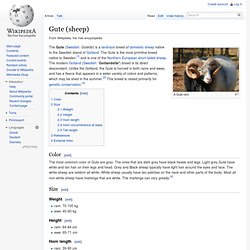
The most common color of Gute are grey. The ones that are dark grey have black heads and legs. Light grey Gute have white and tan hair on their legs and head. Grey and Black sheep typically have light hair around the eyes and face. The white sheep are seldom all white. Navajo-Churro sheep. The Navajo-Churro, or Churro for short,[1] is a breed of domestic sheep originating with the Spanish Churra sheep obtained by the Navajo Indian, Hopi and other Native American tribes around the 1500's during the Spanish Conquest.

The breed is renowned for its hardiness and adaptability to extremes of climate. Its wool consists of a protective topcoat and soft undercoat. Some rams have four fully developed horns, a trait shared with few other breeds in the world. The Navajo-Churro has also gained popularity with its low-maintenance reputation, resistance to disease, and lean meat. Some may even say they are very personable. Jacob (sheep) Peter Paul Rubens, The Reconciliation of Jacob and Esau, 1624.
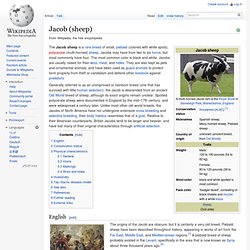
Two long-tailed sheep are visible in the foreground of this painting. Spælsau (sheep) A Spælsau in Norway The Spælsau (Old Norwegian Short Tail Landrace, Gamalnorsk spæl Norwegian) is a breed of sheep from Norway.
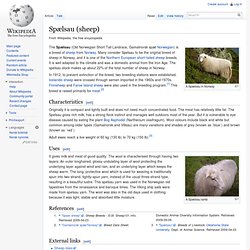
Many consider Spelsau to be the original breed of sheep in Norway, and it is one of the Northern European short-tailed sheep breeds. It is well adapted to the climate and was a domestic animal from the Iron Age. The spelsau stock makes up about 22% of the total number of sheep in Norway. Originally it is compact and lightly built and does not need much concentrated food.
Adult ewes reach a live weight of 60 kg (130 lb) to 70 kg (150 lb).[3] Zwartbles. Zwartbles in the United Kingdom The Zwartbles is a breed of domestic sheep originating in the Friesland region of the north Netherlands.

There it was primarily used for the production of sheep milk as well as lamb and mutton. They were often kept alongside dairy cattle herds. Breed characteristics[edit] Zwartbles are known for being docile, friendly, easy lambing, prolific, milky and being excellent mothers. Racka. A flock of Racka sheep Originating in Hungary, the Racka has existed since at least the 1800, when the first registry was established.
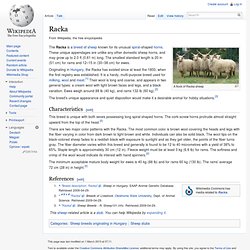
It is a hardy, multi-purpose breed used for milking, wool and meat.[1] Their wool is long and coarse, and appears in two general types: a cream wool with light brown faces and legs, and a black variation. Ewes weigh around 88 lb (40 kg), and rams 132 lb (60 kg).[2] The breed's unique appearance and quiet disposition would make it a desirable animal for hobby situations.[3] Characteristics[edit] This breed is unique with both sexes possessing long spiral shaped horns. There are two major color patterns with the Racka.
Manx Loaghtan. The Manx Loaghtan is a breed of sheep (Ovis aries) native to the Isle of Man.
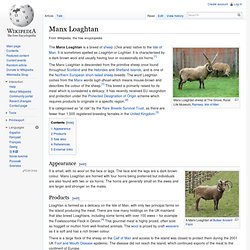
It is sometimes spelled as Loaghtyn or Loghtan. It is characterised by a dark brown wool and usually having four or occasionally six horns.[1] Rambouillet (sheep) Rambouillet ram. The Rambouillet is a breed of sheep also known as the Rambouillet Merino or the French Merino. The development of the Rambouillet breed started in 1786, when Louis XVI purchased over 300 Spanish Merinos (318 ewes, 41 rams, 7 wethers) from his cousin, King Charles III of Spain. The flock was subsequently developed on an experimental royal farm, the Bergerie royale (now Bergerie nationale) owned by Louis XVI, and built on his Domain of Rambouillet, 50 km southwest of Paris.